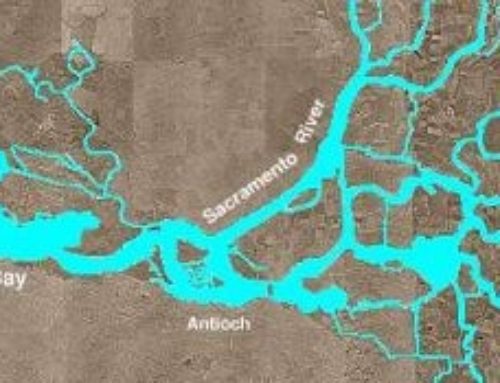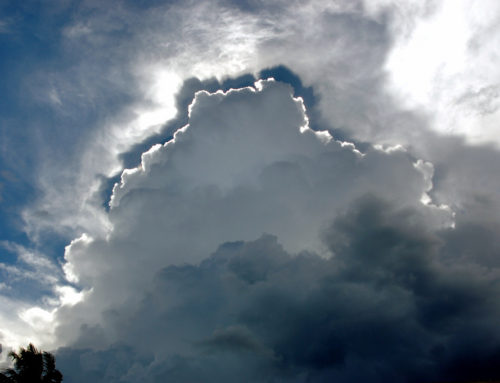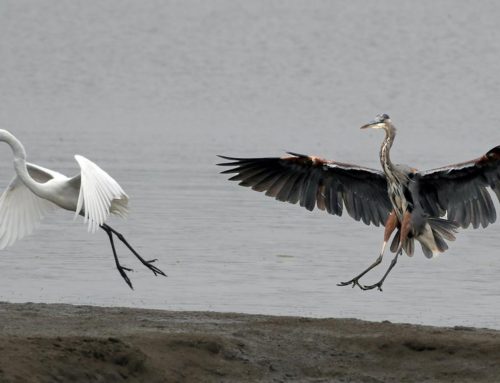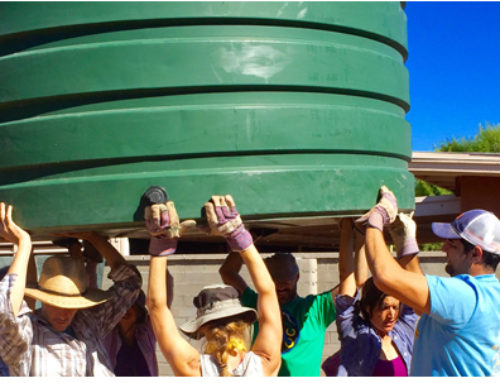Photo by Carlo Bautista
A “crisis” like the 2014 drought, is a snapshot of humanity’s long term relationship with the hydrologic cycle, a finite and closed loop system, (disregarding the periodic frozen asteroid hit)! While we can’t, or shouldn’t, control the weather beyond our own reductions related to climate change, we can notice how homo sapiens enter into the flow of the constantly moving natural hydrologic cycle. Are we part of the cycle or are we pushing so hard against it, that a kind of collapse of the hydrologic cycle in underway? Will we go back to “normal” if and when heavy rains fall?
Out the last 100 years, California has been in a drought 37 of those years, making the 100 year drought norm for CA 37% of time. Over the last millennium, California has baked in two droughts in the previous millennium, the first from 892 to 1112 A.D. lasting 220 years, and the second from and from 1209 to 1350 A.D. settling in for 140 years. Talk about perspective! 220 and 140 years. That’s 370 years in the last 1000 years – again 37% of the time.
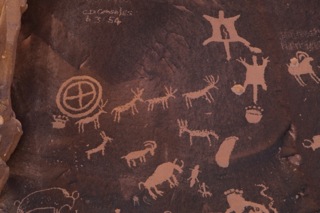
Photo by Ken Kanasawa
Nevertheless, in California, we still do not manage for drought conditions, but treat them as exceptional cases in our approach to managing limited river flows and groundwater for growing water demands in the state.
Conservation rhetoric only really kicks in when the severity of drought years hits. Suddenly the Governor is standing on his front porch yelling, “Drought, Drought!” and the mass media picks up his cry with alarmist headlines (which, by the way, are quite warranted, but not suddenly or only now). State and water agencies have the “go ahead” to focus on conservation again, even if the funding for these programs dried up between droughts. Facebook is full of “Rain Dance” organizing. People are actually willing to get up on their feet at a designated time to join others dancing with the intention of bringing down the rain.
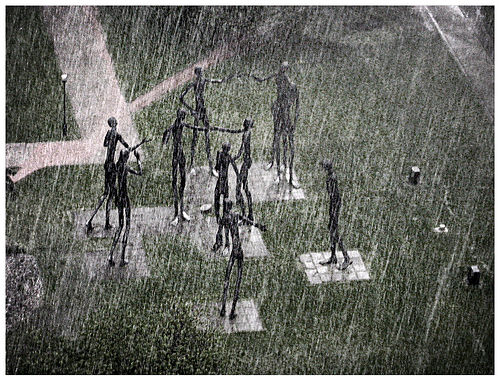
Photo by Ra McGuire
But are we also willing to take the daily steps – whether urbanite or agriculturist or policy maker – to will defray the impacts of dry years and drought years which we find ourselves in 37% of the time, with climate change bringing on a potential for increasingly dry years?
Meaning that the CA State Water Plan and CA water agencies’ management plans (which include supply and demand forecasts and planning), rewritten every four years, seem to forget CA’s norm as a drought zone 1/3 of the time, California’s best strategy is to plan for drought as an increasing norm and turn its eyes toward water conservation and reuse, noit as “conservation” but as standard practice. So that, even in the years when rain is falling more steadily, we continue our normal practices of appropriate water use.
Many articles cite water agencies and government as saying “We are looking for additional water.” Where? In California, we often take 50% or more of a rivers flow, leaving 50% or less water in rivers flows left for sustaining health for riparian ecosystems (of which humans are a part, not separate).
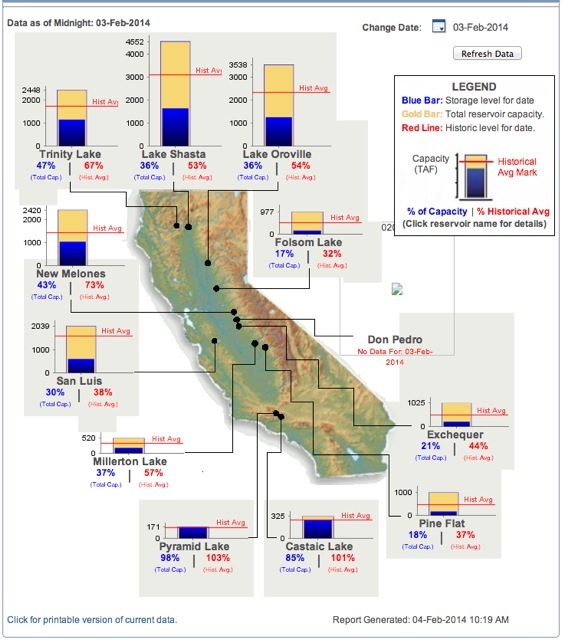
CA Reservoir Levels, Feb 4, 2014
Image From CA Dept. of Water Resources
“More water” generally comes from water transfers between water agencies. Even in a drought year, there are agencies, particularly agricultural, that may be holding onto a surplus of water from rivers or groundwater, allowable based on their water rights. Transfers can be costly and frequently include a great political jockeying, whether they be long or short term transfers. Rather than reducing water use, transfers enable business as usual, rather than smarter, appropriate management of limited resources. Another recent suggestion of CA’s GOP is to boost pumping in the SF Bay Delta, already highly stressed from overdraughts, and to stop San Joaquin ERiver restoration.
According to a UC Davis study comparing water use in two drought-prone areas, California and Australia, “(w)hile California’s per-capita use dropped about 10% from 2000-2009, Australia reduced percapita use by about 35%. Three actions contributing to Australia’s reduced water use are the adoption of outdoor water restrictions, lower-flush toilets, and water pricing.”
In many areas of Australia, graywater is the largest source of water supply, states the same UC Davis study. And rainwater is third. So if anyone ever tells you that rainwater harvestingdoesn’t make sense in California, tell them they are crazy. It makes even more sense in places where we need to keep every drop on the land where it falls, rather than running down urban sidewalks and streets, dumping chemical and animal feces filled water into streams and bays.
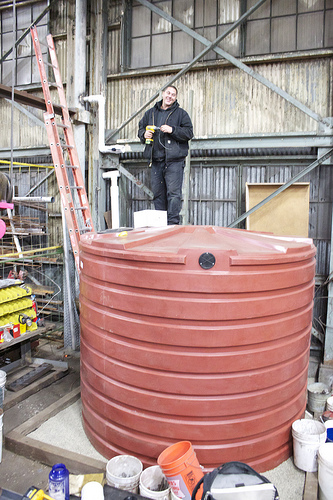
Nick Gardner of Groundation Foundation installing a 3250 gallon rain cistern at American Steel Studios in West Oakland
Photo by Elizabeth Dougherty
If anyone tells you that it’s too hard to put in graywater reuse systems, don’t believe them. Simple Laundry-to-Landscape are cheap and easily installed and can be done without a permit in California. And conservation is so simple, it’s crazy. Put a bucket in your shower to catch heat-up water and dump it in your garden or flush your toilet with it. Put a low-flow aerator on your kitchen sink and reudce in an instant. Get that low flow toilet you’ve been wanting. Call your water agency and ask for rebates on these or take advantage of existing rebates and incentives.
And, if we can’t see our way to doing it voluntarily, then counties, cities, and/or the state should be making mandatory water strictions. Tuolumne County, at the headwaters of San Francisco’s water supply from the Tuolumne River, skipped Stage II and went straight for Stage III madatory restrictions, aiming for 50% reduction in water use. Meanwile, San Francisco, the primary Tuolumne River end user, is still meandering it’s way through 20% voluntary restrictions. I don’t think it’s working!

San Fracisco, a block from City Hall, Feb 3, 2014
Photo by Elizabeth Dougherty
In addition to the CA State Water Project, which is giving no water at all, areas in CA with Mandatory Restrictions in place as of 2.4.14:
City of Santa Cruz – Stage 3
City of Healdsburg – Stage 2
City of Calistoga – Stage 2
City of Cloverdale – Stage 2
City of Woodland – Stage 2
Tuolumne County – Stage 3
County of San Diego – Stage 2
Continue Reading on the Subject of Drought Management and Water Reuse as Primary Water Sources:
Wholly H2O Forum, June 2011 – Managing Rainwater as a Primary Water Source in Hawaii
Geek out on UC Davis Australia vs California Water Use Study
Does rainwater harvesting make sense in California?
** 37 years = 1917-1921, 1922-1926, 1943-1951, 1959-1962, 1976-1977, 1987-1992, 2000-2006, 2007-2009, 2013-2014



